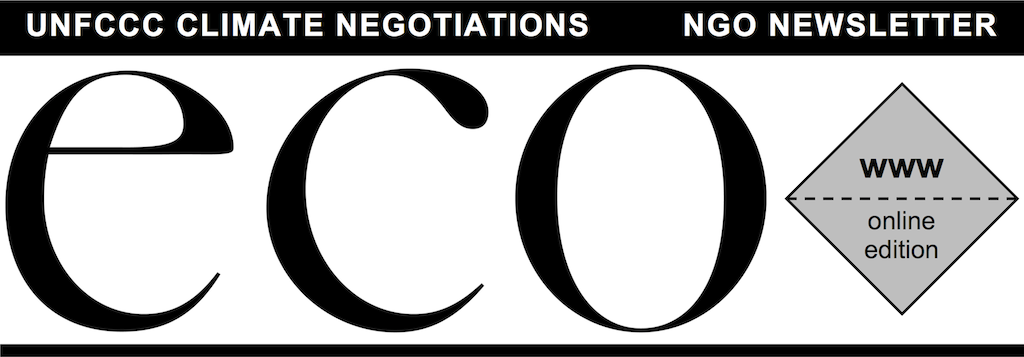Monthly Archive: April 2013
You Can’t Feed Your Addiction and Break It, Too
While delegates will be discussing low emission development opportunities in today’s workshop, many of your countries are still feeding their tragic addiction to fossil fuels. You say you want to keep global warming below 2°C and to keep the door open for 1.5°C, but in fact you are consuming fossil fuels as if 4 degrees was the new 2 degrees.
The International Monetary Fund tells us that this addiction is costing your taxpayers USD 1.9 trillion each year in subsidies for the fossil fuel industry (FYI, for comparison, 1.9 trillion seconds is about 60,000 years!). As shown recently by the International Energy Agency, the result of this is a continuous rise of global carbon emissions each year, while we know that emissions should in fact peak well before 2015.
The archaic, continued support for fossil fuels means that they remain artificially profitable and that low carbon alternatives such as renewable energy sources and energy efficiency are emerging much slower than they could. Let’s be honest here: you are not aiming for a 2°C world. No, in fact you are undermining the development of these low carbon opportunities, which could create local jobs and steer innovation. Instead you line the pockets of the fossil fuel dealers and encourage them to invest further in a 4+°C future.
... Read more ...
On Equity: Part 1
ECO was positively surprised, during yesterday’s ADP2 opening and the following workshop, hearing Parties expressing the fact that equity can’t be neglected in the negotiations – a viewpoint that ECO shared long ago. Now that ECO and Parties have this common understanding on the importance of equity for the 2015 deal, let us suggest a way ahead: Parties should consider the equity spectrum approach.
Firstly, the core equity principles should be identified, such as the adequacy principle, CBDR+RC, the right to sustainable development and the precautionary principle. In the equity spectrum approach, the “equity index” would then be composed of a basket of more specific equity indicators. This basket would have to contain well-designed indicators that, taken together, measure both responsibility and capacity. It could include indicators for, inter alia, per capita income and standard of living, per capita emissions and historical responsibility, and domestic income inequality.
Once this basket of indicators is agreed, countries’ mitigation pledges could be measured against this set. This would create the basis for assessing pledges in terms of their adequacy for staying below 2°C and keeping 1.5°C in reach, and in terms of a fair and equitable sharing of the mitigation burden and atmospheric space.
... Read more ...
Raise the Bar or Stay Home
Even as CO2 concentrations are about to break the 400ppm threshold, fresh climate disasters are announced all over the planet, and carbon prices are collapsing because of lax targets on par with BAU, countries have apparently come to the UNFCCC ADP meeting in Bonn with nothing to offer. Developed countries seem to be looking off in the distance beyond 2020, with images of universal participation and bottom-up national pledges dancing in their heads. Mundane issues like what has to change in the next 6 years and 8 months to stay below 2 degrees are apparently the farthest thing from their minds.
Parties are in Bonn to get down to work on two tasks – raise pre-2020 ambition and craft the next legally binding agreement to reduce greenhouse gas pollution – potentially the most significant global treaty that will ever be negotiated. Delegates should be mindful of the fact that that your work this week and over the next few years will secure you a place in the history books. Whether the legacy you leave behind is positive or abysmal depends on your creativity, commitment, negotiating skills and sheer hard craft. In short, you will have to be prepared to pull out all the stops.
... Read more ...
On Equity: Part 2
The following are excerpts from a particularly incisive intervention in the ADP workshop yesterday afternoon. In case you missed it, ECO suggests you take a look. And if you didn’t miss it, ECO suggests you take a look anyway, since it’s a subject Parties need to work much more on:
“What is needed is a process that would allow for a proper equity review of the pledges, to be conducted in parallel with the equally-critical science review.
To that end, the Parties should launch an open, expert process to develop an equity reference framework that is suitable to the evaluation of national pledges. This framework would have to be designed to maximize both ambition and participation. Parties, when making pledges, would be guided by the knowledge that these would be evaluated within both the science and equity reviews.
How to think about such an equity review? The first point is that the demands of equity have already been agreed. This is true at the level of the Convention’s keystone text on CBDR & RC, and it’s true of the four fundamental equity principles – ambition, responsibility, capacity, and development need – that underlie the principle of CBDR & RC and, of course, our shared vision of ‘equitable access to sustainable development’ as well.
... Read more ...
Putting the “2 (degrees)” back in Workstream 2
It is well-trodden ground that there is a huge gap between what Parties say they want (staying below 2°C and keeping the door open to 1.5°C) and what Parties have pledged to contribute between now and 2020 to achieve that planetary necessity. In theory, Workstream 2 has already identified how to bridge the gap through: 1) improving developed countries’ woefully inadequate 2020 emission reduction targets; 2) identifying ways to enable and support developing countries in upping their own pre-2020 ambition; and 3) joint complementary action in addition to the first two areas on everything from phasing out HFCs to fossil fuel subsidies. The task now is to JUST DO IT.
ECO thought “doing it” would require no explanation, but some recent happenings in many developed countries are getting their positions all wrong. First and foremost – and we really thought this was obvious – the thing that needs to go up is the target, not the temperature. For the EU this means moving to 30% – a move which really shouldn’t be that difficult considering that it has already achieved its 20% target almost 8 years ahead of schedule and will actually achieve more than that (around 25-27%) by 2020. How can the EU host 2 COPs over the next 3 years and ask the rest of the world to do more while it decides to take a break?
... Read more ...
Mothers of Ambition
Plato observed in The Republic that necessity is the mother of invention. Parties, he was speaking about you. Humanity formed the State to enable the conditions for sufficient food, shelter and security. Today we face an unprecedented challenge – how will we respond?
At this early stage in developing the global climate agreement in 2015, “ambition” dominates the agenda – and for good reason. The IPCC’s forthcoming AR5 will shine a bright and unyielding light on the planetary emergency we now face.
It’s not just about the need to close the emissions gap. While those 11 gigatonnes will help the atmosphere, they won’t break the back of the politics to get us below 2°C. What is required is for collective agreement to dramatically change the course of human development with the climate clock ticking. So it’s simple: the 2015 deal must deliver ambition compatible with a below 2°C trajectory.
There is a sense in some quarters that a top-down method to achieve that kind of ambition is out of reach politically, so a bottom-up approach will have to suffice. But these underachievers are missing the point. Either they wilfully ignore the fact that climate change will ravage the globe and its inhabitants, or they think Plan B[ottom-up] can keep us out of harm’s reach of unavoidable climate change.
... Read more ...


